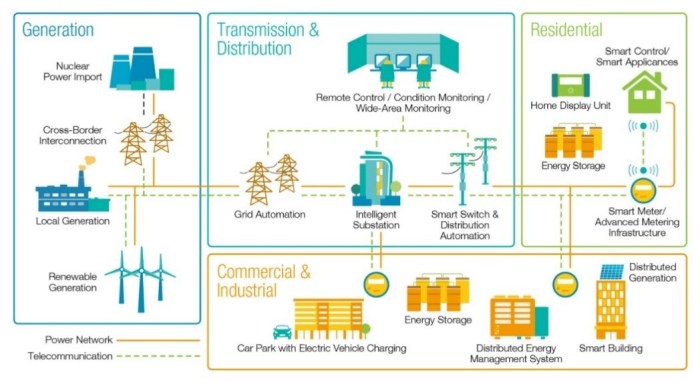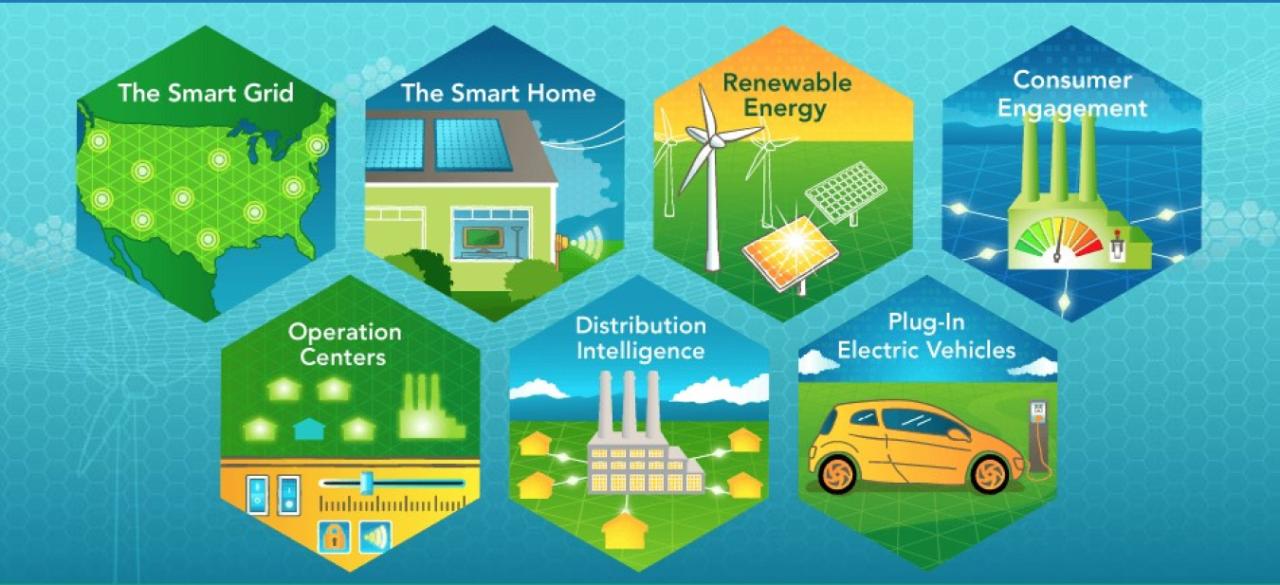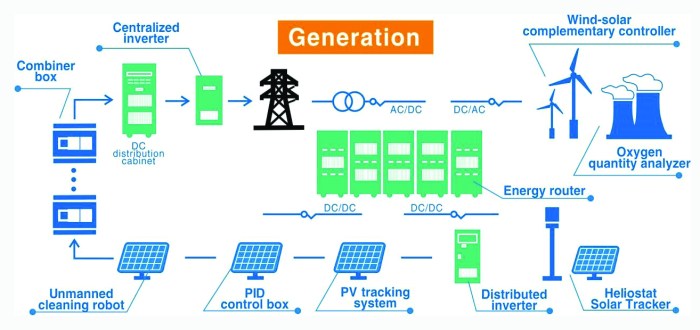
The impact of smart grids on renewable energy distribution sets the stage for this enthralling narrative, offering readers a glimpse into a story that is rich in detail and brimming with originality from the outset. Smart grids play a crucial role in optimizing the distribution of renewable energy sources, enhancing energy efficiency, and ensuring grid stability and reliability.
Let’s delve into the fascinating world where technology meets sustainability.
Overview of Smart Grids and Renewable Energy Distribution

Smart grids play a crucial role in optimizing the distribution of renewable energy sources by utilizing advanced technologies to efficiently manage the flow of electricity. These grids enable the integration of renewable energy generation, storage, and consumption in a more dynamic and flexible manner.
Enhanced Monitoring and Control
Smart grids utilize real-time data and analytics to monitor the performance of renewable energy sources, such as solar panels and wind turbines. By constantly analyzing this data, smart grids can adjust the distribution of energy to meet demand and minimize wastage.
Grid Resilience and Stability
Integrating smart grids with renewable energy distribution systems enhances grid resilience and stability. These grids can quickly detect and respond to fluctuations in supply and demand, ensuring a reliable and secure energy supply even with intermittent renewable sources.
Optimized Energy Storage
Smart grids facilitate efficient energy storage solutions, such as batteries, to store excess energy generated from renewable sources during peak production periods. This stored energy can then be utilized during high demand periods or when renewable sources are not actively generating electricity.
Improved Demand Response
By enabling better communication between energy providers and consumers, smart grids allow for improved demand response capabilities. Consumers can adjust their energy usage based on real-time pricing and availability of renewable energy, leading to more sustainable energy consumption patterns.
Impact on Energy Efficiency

Smart grids play a crucial role in enhancing energy efficiency in the distribution of renewable energy. By incorporating advanced technologies and real-time data analytics, smart grids optimize the delivery of electricity from renewable sources to end-users, resulting in significant improvements in energy efficiency.
Enhanced Monitoring and Control Systems
Smart grids enable utilities to monitor energy consumption patterns in real-time and make necessary adjustments to optimize energy distribution. This proactive approach helps in reducing energy losses and ensuring more efficient use of renewable energy resources.
Demand Response Programs
With smart grids, utilities can implement demand response programs that incentivize consumers to adjust their energy usage during peak hours. By shifting energy consumption to off-peak periods, smart grids help reduce strain on the grid and minimize wastage of renewable energy.
Integration of Energy Storage
Smart grids facilitate the integration of energy storage systems, such as batteries, to store excess renewable energy for later use. This storage capability helps in balancing supply and demand, improving overall energy efficiency in the distribution process.
Integration of Variable Renewable Energy Sources
Smart grids play a crucial role in facilitating the integration of variable renewable energy sources such as solar and wind. These energy sources are inherently intermittent and dependent on weather conditions, making their integration into the grid a complex process.
Challenges in Integrating Variable Renewable Energy Sources
- Intermittency: Solar and wind energy production can vary based on weather conditions, leading to fluctuations in power generation.
- Grid Stability: The variability of renewable energy sources can pose challenges to grid stability and reliability.
- Storage Needs: Without effective storage solutions, excess energy generated during peak production periods may go to waste.
Smart Grids Balancing Renewable Energy Variability
- Advanced Monitoring: Smart grids enable real-time monitoring of energy production and consumption, allowing for better management of variable renewable sources.
- Demand Response: Smart grids can adjust energy consumption patterns based on renewable energy availability, helping balance supply and demand.
- Energy Forecasting: By using predictive analytics, smart grids can anticipate renewable energy generation, aiding in grid stability.
Grid Stability and Reliability

Smart grids play a crucial role in enhancing grid stability and reliability in renewable energy distribution. By incorporating advanced technologies and communication systems, smart grids are able to monitor, control, and optimize the flow of electricity more efficiently.
Impact on Reducing Grid Disturbances
Smart grids help in reducing grid disturbances by enabling real-time monitoring of the electricity network. This allows for quick detection of faults or fluctuations in the system, leading to faster response times and minimization of potential disruptions. Additionally, smart grids facilitate self-healing capabilities, where the system can automatically reconfigure itself to maintain smooth operations in case of outages or disturbances.
Contribution to Reducing Power Outages
One of the key advantages of smart grids is their ability to reduce power outages by improving the overall reliability of the grid. Through predictive maintenance and remote monitoring, smart grids can identify potential issues before they escalate into full-blown outages.
This proactive approach helps utilities address problems swiftly and prevent widespread blackouts, ensuring a more reliable supply of electricity to consumers.
Enhancing Resilience of Renewable Energy Distribution Systems
Smart grids enhance the resilience of renewable energy distribution systems by enabling better integration of variable energy sources, such as solar and wind power. By leveraging real-time data and analytics, smart grids can balance the fluctuating nature of renewable energy generation with the demand for electricity.
This leads to a more stable and resilient energy infrastructure that can withstand sudden changes in supply or demand, ultimately improving the overall reliability of the grid.
Final Conclusion
In conclusion, the integration of smart grids into renewable energy distribution systems opens up a world of possibilities for a more sustainable future. By balancing the variability of renewable energy sources, reducing energy wastage, and enhancing grid stability, smart grids are paving the way for a greener tomorrow.
Embrace the power of innovation and technology in shaping a more efficient and eco-friendly energy landscape.
General Inquiries
How do smart grids help reduce energy wastage in the distribution process?
Smart grids use advanced monitoring and control systems to optimize energy flow, reduce transmission losses, and match supply with demand more effectively, thereby minimizing energy wastage.
What are the challenges involved in integrating variable renewable energy sources without smart grid technology?
Without smart grid technology, integrating variable renewable energy sources poses challenges in managing the intermittent nature of sources like solar and wind, leading to grid instability and inefficiencies in energy distribution.
How do smart grids enhance grid stability and reliability in renewable energy distribution?
Smart grids improve grid stability and reliability by enabling real-time monitoring, rapid response to fluctuations in supply and demand, and better management of renewable energy sources, reducing the risk of power outages and disturbances.











